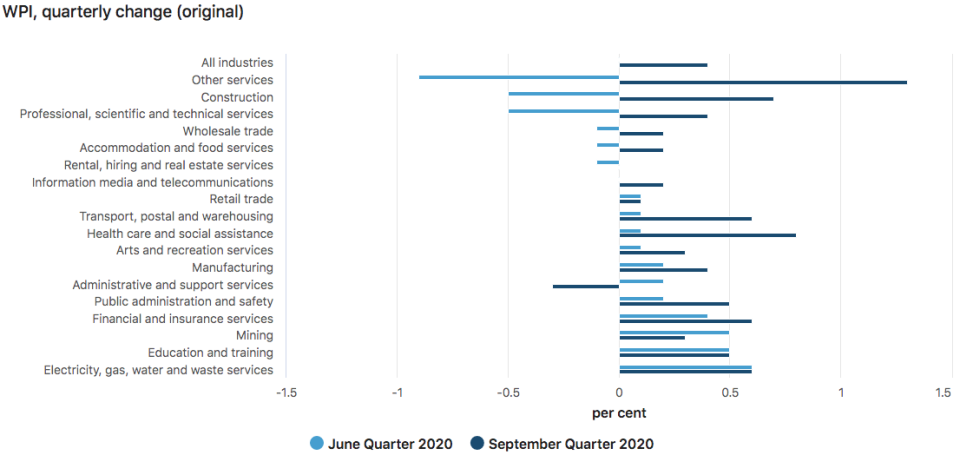'Urgent crisis': Aussie wage growth sinks to historic lows

Wage growth in Australia has slumped to historic lows, with the wage percentage index (WPI) rising just 0.1 per cent over the September quarter, new data from the Australian Bureau of Statistics (ABS) shows.
That’s the second consecutive quarter of record low wage growth, and brings annual wage growth to 1.4 per cent - the slowest pace since the ABS began its records in 1997.
Head of price statistics at the ABS, Andrew Tomadini, said while the September quarter was usually a quarter of solid wage growth, Covid-19 saw a subdued rate of growth instead.
“Organisations continued to adjust to the economic uncertainty, recording fewer end of financial year wage reviews and delaying enterprise bargaining agreement increases,” he said.
“This led to a significantly reduced number of jobs recording wage rises when compared to previous September quarters.
“Additionally, the staggered implementation schedule of the Fair Work Commission annual wage review moved some regular September quarter wage rises to later quarters."
Wage growth was staggered across industries, with the largest rise seen in the “other services” industry (1.3 per cent), while the “administrative and support services” industry experiencing the largest fall (-0.3 per cent per cent).

The construction, health care and social assistance services industries also experienced large gains, while the retail, accommodation and food services and arts and recreation services industries did not.
By state, South Australia recorded the highest annual wage growth of 1.8 per cent, while Victoria recorded the lowest (1.2 per cent).
"September quarter 2020 covers the period when Covid-19 restrictions were impacting parts of Victoria but had started to ease across the majority of other states and we can see the impacts of this in the data,” Tomadini said.
The Australian Council of Trade Unions (ACTU) said the record-low wage growth served as a reminder to the Australian Government that the Covid-19 crisis was still affecting Australians.
“Working people are still on the frontlines of this crisis,” ACTU secretary, Sally McManus, said.
“More than 3 million are reliant on JobKeeper, and 1.4 million people are unemployed and relying on JobSeeker. This crisis has shown that the underlying problems in our economy, low wage growth and spiralling insecure work, need to be addressed urgently.”
McManus said the Government’s decision to suppress public sector wages had flow-on effects to those in the private sector, and more needed to be done to ensure Australians could prepare for their futures.
“Unemployment is projected to hit 8 per cent by Christmas and working people aren’t seeing any recovery in their wages.
“This is not the time to cut back essential support like JobSeeker and JobKeeper. Every cent of this money recirculates in our economy.”
Wages and unemployment
Australia’s unemployment rate rose by just 0.1 per cent to 6.9 per cent in September, with a further 30,000 jobs lost over the course of the month. The minimal change in unemployment likely shows the Australian economy is entering its recovery phase, economists said.
But if unemployment remains high, wage growth will remain low, AMP chief economist, Shane Oliver, told Yahoo Finance.
“Prior to the coronavirus, the unemployment rate was just around 5 per cent,” Oliver said.
“The problem was that underemployment was around 8 per cent. And so that combination of a relatively high level of underemployment was keeping a lid on wages growth.
“We really need to see the unemployment rate pushed a lot lower, and the underemployment rate return to where we were at the start of the year and beyond that,” he said.
However, the Government has predicted the unemployment rate will peak at around 8 per cent as a result of the Covid-19 recession, which spells bad news for wages in Australia.
Federal Budget papers revealed the Government predicts annual wage growth to sit at around 1.25 per cent until June 2021, before rising to 1.5 per cent by June 2022.
The nation’s unemployment rate for the month of October will be released on Thursday.
Are you a millennial or Gen Z-er interested in joining a community where you can learn how to take control of your money? Join us at The Broke Millennials Club on Facebook!
Want to make next year your best year yet? Join us for an Hour of Power at 10am AEDT Tuesday 24 November to discover 21 ways to make your money work for you in 2021. Registrations are now open.


